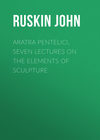Read the book: «Mornings in Florence», page 2
THE SECOND MORNING
THE GOLDEN GATE
To-day, as early as you please, and at all events before doing anything else, let us go to Giotto's own parish-church, Santa Maria Novella. If, walking from the Strozzi Palace, you look on your right for the "Way of the Beautiful Ladies," it will take you quickly there.
Do not let anything in the way of acquaintance, sacristan, or chance sight, stop you in doing what I tell you. Walk straight up to the church, into the apse of it;—(you may let your eyes rest, as you walk, on the glow of its glass, only mind the step, half way;)—and lift the curtain; and go in behind the grand marble altar, giving anybody who follows you anything they want, to hold their tongues, or go away.
You know, most probably, already, that the frescos on each side of you are Ghirlandajo's. You have been told they are very fine, and if you know anything of painting, you know the portraits in them are so. Nevertheless, somehow, you don't really enjoy these frescos, nor come often here, do you?
The reason of which is, that if you are a nice person, they are not nice enough for you; and if a vulgar person, not vulgar enough. But if you are a nice person, I want you to look carefully, to-day, at the two lowest, next the windows, for a few minutes, that you may better feel the art you are really to study, by its contrast with these.
On your left hand is represented the birth of the Virgin, On your right, her meeting with Elizabeth.
You can't easily see better pieces—nowhere more pompous pieces—of flat goldsmiths' work. Ghirlandajo was to the end of his life a mere goldsmith, with a gift of portraiture. And here he has done his best, and has put a long wall in wonderful perspective, and the whole city of Florence behind Elizabeth's house in the hill country; and a splendid bas-relief, in the style of Luca della Robbia, in St. Anne's bedroom; and he has carved all the pilasters, and embroidered all the dresses, and flourished and trumpeted into every corner; and it is all done, within just a point, as well as it can be done; and quite as well as Ghirlandajo could do it. But the point in which it just misses being as well as it can be done, is the vital point. And it is all simply—good for nothing.
Extricate yourself from the goldsmith's rubbish of it, and look full at the Salutation. You will say, perhaps, at first, "What grand and graceful figures!" Are you sure they are graceful? Look again and you will see their draperies hang from them exactly as they would from two clothes-pegs. Now, fine drapery, really well drawn, as it hangs from a clothes-peg, is always rather impressive, especially if it be disposed in large breadths and deep folds; but that is the only grace of their figures.
Secondly. Look at the Madonna, carefully. You will find she is not the least meek—only stupid,—as all the other women in the picture are.
"St. Elizabeth, you think, is nice"? Yes; "and she says, 'Whence is this to me, that the mother of my Lord should come to me?' really with a great deal of serious feeling?" Yes, with a great deal. Well, you have looked enough at those two. Now—just for another minute—look at the birth of the Virgin. "A most graceful group, (your Murray's Guide tells you,) in the attendant servants." Extremely so. Also, the one holding the child is rather pretty. Also, the servant pouring out the water does it from a great height, without splashing, most cleverly. Also, the lady coming to ask for St. Anne, and see the baby, walks majestically and is very finely dressed. And as for that bas-relief in the style of Luca della Robbia, you might really almost think it was Luca! The very best plated goods, Master Ghirlandajo, no doubt—always on hand at your shop.
Well, now you must ask for the Sacristan, who is civil and nice enough, and get him to let you into the green cloister, and then go into the less cloister opening out of it on the right, as you go down the steps; and you must ask for the tomb of the Marcheza Stiozzi Ridolfi; and in the recess behind the Marcheza's tomb—very close to the ground, and in excellent light, if the day is fine—you will see two small frescos, only about four feet wide each, in odd-shaped bits of wall—quarters of circles; representing—that on the left, the Meeting of Joachim and Anna at the Golden Gate; and that on the right, the Birth of the Virgin.
No flourish of trumpets here, at any rate, you think! No gold on the gate; and, for the birth of the Virgin—is this all! Goodness!—nothing to be seen, whatever, of bas-reliefs, nor fine dresses, nor graceful pourings out of water, nor processions of visitors?
No. There's but one thing you can see, here, which you didn't in Ghirlandajo's fresco, unless you were very clever and looked hard for it—the Baby! And you are never likely to see a more true piece of Giotto's work in this world.
A round-faced, small-eyed little thing, tied up in a bundle!
Yes, Giotto was of opinion she must have appeared really not much else than that. But look at the servant who has just finished dressing her;—awe-struck, full of love and wonder, putting her hand softly on the child's head, who has never cried. The nurse, who has just taken her, is—the nurse, and no more: tidy in the extreme, and greatly proud and pleased: but would be as much so with any other child.
Ghirlandajo's St. Anne (I ought to have told you to notice that,—you can afterwards) is sitting strongly up in bed, watching, if not directing, all that is going on. Giotto's lying down on the pillow, leans her face on her hand; partly exhausted, partly in deep thought. She knows that all will be well done for the child, either by the servants, or God; she need not look after anything.
At the foot of the bed is the midwife, and a servant who has brought drink for St. Anne. The servant stops, seeing her so quiet; asking the midwife, Shall I give it her now? The midwife, her hands lifted under her robe, in the attitude of thanksgiving, (with Giotto distinguishable always, though one doesn't know how, from that of prayer,) answers, with her look, "Let be—she does not want anything."
At the door a single acquaintance is coming in, to see the child. Of ornament, there is only the entirely simple outline of the vase which the servant carries; of colour, two or three masses of sober red, and pure white, with brown and gray.
That is all. And if you can be pleased with this, you can see Florence. But if not, by all means amuse yourself there, if you find it amusing, as long as you like; you can never see it.
But if indeed you are pleased, ever so little, with this fresco, think what that pleasure means. I brought you, on purpose, round, through the richest overture, and farrago of tweedledum and tweedledee, I could find in Florence; and here is a tune of four notes, on a shepherd's pipe, played by the picture of nobody; and yet you like it! You know what music is, then. Here is another little tune, by the same player, and sweeter. I let you hear the simplest first.
The fresco on the left hand, with the bright blue sky, and the rosy figures! Why, anybody might like that!
Yes; but, alas, all the blue sky is repainted. It was blue always, however, and bright too; and I dare say, when the fresco was first done, anybody did like it.
You know the story of Joachim and Anna, I hope? Not that I do, myself, quite in the ins and outs; and if you don't I'm not going to keep you waiting while I tell it. All you need know, and you scarcely, before this fresco, need know so much, is, that here are an old husband and old wife, meeting again by surprise, after losing each other, and being each in great fear;—meeting at the place where they were told by God each to go, without knowing what was to happen there.
"So they rushed into one another's arms, and kissed each other."
No, says Giotto,—not that.
"They advanced to meet, in a manner conformable to the strictest laws of composition; and with their draperies cast into folds which no one until Raphael could have arranged better."
No, says Giotto,—not that.
St. Anne has moved quickest; her dress just falls into folds sloping backwards enough to tell you so much. She has caught St. Joachim by his mantle, and draws him to her, softly, by that. St. Joachim lays his hand under her arm, seeing she is like to faint, and holds her up. They do not kiss each other—only look into each other's eyes. And God's angel lays his hand on their heads.
Behind them, there are two rough figures, busied with their own affairs,—two of Joachim's shepherds; one, bare headed, the other wearing the wide Florentine cap with the falling point behind, which is exactly like the tube of a larkspur or violet; both carrying game, and talking to each other about—Greasy Joan and her pot, or the like. Not at all the sort of persons whom you would have thought in harmony with the scene;—by the laws of the drama, according to Racine or Voltaire.
No, but according to Shakespeare, or Giotto, these are just the kind of persons likely to be there: as much as the angel is likely to be there also, though you will be told nowadays that Giotto was absurd for putting him into the sky, of which an apothecary can always produce the similar blue, in a bottle. And now that you have had Shakespeare, and sundry other men of head and heart, following the track of this shepherd lad, you can forgive him his grotesques in the corner. But that he should have forgiven them to himself, after the training he had, this is the wonder! We have seen simple pictures enough in our day; and therefore we think that of course shepherd boys will sketch shepherds: what wonder is there in that?
I can show you how in this shepherd boy it was very wonderful indeed, if you will walk for five minutes back into the church with me, and up into the chapel at the end of the south transept,—at least if the day is bright, and you get the Sacristan to undraw the window-curtain in the transept itself. For then the light of it will be enough to show you the entirely authentic and most renowned work of Giotto's master; and you will see through what schooling the lad had gone.
A good and brave master he was, if ever boy had one; and, as you will find when you know really who the great men are, the master is half their life; and well they know it—always naming themselves from their master, rather than their families. See then what kind of work Giotto had been first put to. There is, literally, not a square inch of all that panel—some ten feet high by six or seven wide—which is not wrought in gold and colour with the fineness of a Greek manuscript. There is not such an elaborate piece of ornamentation in the first page of any Gothic king's missal, as you will find in that Madonna's throne;—the Madonna herself is meant to be grave and noble only; and to be attended only by angels.
And here is this saucy imp of a lad declares his people must do without gold, and without thrones; nay, that the Golden Gate itself shall have no gilding that St. Joachim and St. Anne shall have only one angel between them: and their servants shall have their joke, and nobody say them nay!
It is most wonderful; and would have been impossible, had Cimabue been a common man, though ever so great in his own way. Nor could I in any of my former thinking understand how it was, till I saw Cimabue's own work at Assisi; in which he shows himself, at heart, as independent of his gold as Giotto,—even more intense, capable of higher things than Giotto, though of none, perhaps, so keen or sweet. But to this day, among all the Mater Dolorosas of Christianity, Cimabue's at Assisi is the noblest; nor did any painter after him add one link to the chain of thought with which he summed the creation of the earth, and preached its redemption.
He evidently never checked the boy, from the first day he found him. Showed him all he knew: talked with him of many things he felt himself unable to paint: made him a workman and a gentleman,—above all, a Christian,—yet left him—a shepherd. And Heaven had made him such a painter, that, at his height, the words of his epitaph are in nowise overwrought: "Ille ego sum, per quem pictura extincta revixit."
A word or two, now, about the repainting by which this pictura extincta has been revived to meet existing taste. The sky is entirely daubed over with fresh blue; yet it leaves with unusual care the original outline of the descending angel, and of the white clouds about his body. This idea of the angel laying his hands on the two heads—(as a bishop at Confirmation does, in a hurry; and I've seen one sweep four together, like Arnold de Winkelied),—partly in blessing, partly as a symbol of their being brought together to the same place by God,—was afterwards repeated again and again: there is one beautiful little echo of it among the old pictures in the schools of Oxford. This is the first occurrence of it that I know in pure Italian painting; but the idea is Etruscan-Greek, and is used by the Etruscan sculptors of the door of the Baptistery of Pisa, of the evil angel, who "lays the heads together" of two very different persons from these—Herodias and her daughter.
Joachim, and the shepherd with the larkspur cap, are both quite safe; the other shepherd a little reinforced; the black bunches of grass, hanging about are retouches. They were once bunches of plants drawn with perfect delicacy and care; you may see one left, faint, with heart-shaped leaves, on the highest ridge of rock above the shepherds. The whole landscape is, however, quite undecipherably changed and spoiled.
You will be apt to think at first, that if anything has been restored, surely the ugly shepherd's uglier feet have. No, not at all. Restored feet are always drawn with entirely orthodox and academical toes, like the Apollo Belvidere's. You would have admired them very much. These are Giotto's own doing, every bit; and a precious business he has had of it, trying again and again—in vain. Even hands were difficult enough to him, at this time; but feet, and bare legs! Well, he'll have a try, he thinks, and gets really a fair line at last, when you are close to it; but, laying the light on the ground afterwards, he dare not touch this precious and dear-bought outline. Stops all round it, a quarter of an inch off,5 with such effect as you see. But if you want to know what sort of legs and feet he can draw, look at our lambs, in the corner of the fresco under the arch on your left!
And there is one on your right, though more repainted—the little Virgin presenting herself at the Temple,—about which I could also say much. The stooping figure, kissing the hem of her robe without her knowing, is, as far as I remember, first in this fresco; the origin, itself, of the main design in all the others you know so well; (and with its steps, by the way, in better perspective already than most of them).
"This the original one!" you will be inclined to exclaim, if you have any general knowledge of the subsequent art. "This Giotto! why it's a cheap rechauffé of Titian!" No, my friend. The boy who tried so hard to draw those steps in perspective had been carried down others, to his grave, two hundred years before Titian ran alone at Cadore. But, as surely as Venice looks on the sea, Titian looked upon this, and caught the reflected light of it forever.
What kind of boy is this, think you, who can make Titian his copyist,—Dante his friend? What new power is here which is to change the heart of Italy?—can you see it, feel it, writing before you these words on the faded wall?
"You shall see things—as they Are."
"And the least with the greatest, because God made them."
"And the greatest with the least, because God made you, and gave you eyes and a heart."
I. You shall see things—as they are. So easy a matter that, you think? So much more difficult and sublime to paint grand processions and golden thrones, than St. Anne faint on her pillow, and her servant at pause?
Easy or not, it is all the sight that is required of you in this world,—to see things, and men, and yourself,—as they are.
II. And the least with the greatest, because God made them,—shepherd, and flock, and grass of the field, no less than the Golden Gate.
III. But also the golden gate of Heaven itself, open, and the angels of God coming down from it.
These three things Giotto taught, and men believed, in his day. Of which Faith you shall next see brighter work; only before we leave the cloister, I want to sum for you one or two of the instant and evident technical changes produced in the school of Florence by this teaching.
One of quite the first results of Giotto's simply looking at things as they were, was his finding out that a red thing was red, and a brown thing brown, and a white thing white—all over.
The Greeks had painted anything anyhow,—gods black, horses red, lips and cheeks white; and when the Etruscan vase expanded into a Cimabue picture, or a Tafi mosaic, still,—except that the Madonna was to have a blue dress, and everything else as much gold on it as could be managed,—there was very little advance in notions of colour. Suddenly, Giotto threw aside all the glitter, and all the conventionalism; and declared that he saw the sky blue, the tablecloth white, and angels, when he dreamed of them, rosy. And he simply founded the schools of colour in Italy—Venetian and all, as I will show you to-morrow morning, if it is fine. And what is more, nobody discovered much about colour after him.
But a deeper result of his resolve to look at things as they were, was his getting so heartily interested in them that he couldn't miss their decisive moment. There is a decisive instant in all matters; and if you look languidly, you are sure to miss it. Nature seems always, somehow, trying to make you miss it. "I will see that through," you must say, "with out turning my head"; or you won't see the trick of it at all. And the most significant thing in all his work, you will find hereafter, is his choice of moments. I will give you at once two instances in a picture which, for other reasons, you should quickly compare with these frescos. Return by the Via delle Belle Donne; keep the Casa Strozzi on your right; and go straight on, through the market. The Florentines think themselves so civilized, forsooth, for building a nuovo Lung-Arno, and three manufactory chimneys opposite it: and yet sell butchers' meat, dripping red, peaches, and anchovies, side by side: it is a sight to be seen. Much more, Luca della Robbia's Madonna in the circle above the chapel door. Never pass near the market without looking at it; and glance from the vegetables underneath to Luca's leaves and lilies, that you may see how honestly he was trying to make his clay like the garden-stuff. But to-day, you may pass quickly on to the Uffizii, which will be just open; and when you enter the great gallery, turn to the right, and there, the first picture you come at will be No. 6, Giotto's "Agony in the garden."
I used to think it so dull that I could not believe it was Giotto's. That is partly from its dead colour, which is the boy's way of telling you it is night:—more from the subject being one quite beyond his age, and which he felt no pleasure in trying at. You may see he was still a boy, for he not only cannot draw feet yet, in the least, and scrupulously hides them therefore; but is very hard put to it for the hands, being obliged to draw them mostly in the same position,—all the four fingers together. But in the careful bunches of grass and weeds you will see what the fresco foregrounds were before they got spoiled; and there are some things he can understand already, even about that Agony, thinking of it in his own fixed way. Some things,—not altogether to be explained by the old symbol of the angel with the cup. He will try if he cannot explain them better in those two little pictures below; which nobody ever looks at; the great Roman sarcophagus being put in front of them, and the light glancing on the new varnish so that you must twist about like a lizard to see anything. Nevertheless, you may make out what Giotto meant.
"The cup which my Father hath given me, shall I not drink it?" In what was its bitterness?—thought the boy. "Crucifixion?—Well, it hurts, doubtless; but the thieves had to bear it too, and many poor human wretches have to bear worse on our battlefields. But"—and he thinks, and thinks, and then he paints his two little pictures for the predella.
They represent, of course, the sequence of the time in Gethsemane; but see what choice the youth made of his moments, having two panels to fill. Plenty of choice for him—in pain. The Flagellation—the Mocking—the Bearing of the Cross;—all habitually given by the Margheritones, and their school, as extremes of pain.
"No," thinks Giotto. "There was worse than all that. Many a good man has been mocked, spitefully entreated, spitted on, slain. But who was ever so betrayed? Who ever saw such a sword thrust in his mother's heart?"
He paints, first, the laying hands on Him in the garden, but with only two principal figures,—Judas and Peter, of course; Judas and Peter were always principal in the old Byzantine composition,—Judas giving the kiss—Peter cutting off the servant's ear. But the two are here, not merely principal, but almost alone in sight, all the other figures thrown back; and Peter is not at all concerned about the servant, or his struggle with him. He has got him down,—but looks back suddenly at Judas giving the kiss. What!—you are the traitor, then—you!
"Yes," says Giotto; "and you, also, in an hour more."
The other picture is more deeply felt, still. It is of Christ brought to the foot of the cross. There is no wringing of hands or lamenting crowd—no haggard signs of fainting or pain in His body. Scourging or fainting, feeble knee and torn wound,—he thinks scorn of all that, this shepherd-boy. One executioner is hammering the wedges of the cross harder down. The other—not ungently—is taking Christ's red robe off His shoulders. And St. John, a few yards off, is keeping his mother from coming nearer. She looks down, not at Christ; but tries to come.
And now you may go on for your day's seeings through the rest of the gallery, if you will—Fornarina, and the wonderful cobbler, and all the rest of it. I don't want you any more till to-morrow morning.
But if, meantime, you will sit down,—say, before Sandro Botticelli's "Fortitude," which I shall want you to look at, one of these days; (No. 1299, innermost room from the Tribune,) and there read this following piece of one of my Oxford lectures on the relation of Cimabue to Giotto, you will be better prepared for our work to-morrow morning in Santa Croce; and may find something to consider of, in the room you are in. Where, by the way, observe that No. 1288 is a most true early Lionardo, of extreme interest: and the savants who doubt it are—never mind what; but sit down at present at the feet of Fortitude, and read.
Those of my readers who have been unfortunate enough to interest themselves in that most profitless of studies—the philosophy of art—have been at various times teased or amused by disputes respecting the relative dignity of the contemplative and dramatic schools.
Contemplative, of course, being the term attached to the system of painting things only for the sake of their own niceness—a lady because she is pretty, or a lion because he is strong: and the dramatic school being that which cannot be satisfied unless it sees something going on: which can't paint a pretty lady unless she is being made love to, or being murdered; and can't paint a stag or a lion unless they are being hunted, or shot, or the one eating the other.
You have always heard me—or, if not, will expect by the very tone of this sentence to hear me, now, on the whole recommend you to prefer the Contemplative school. But the comparison is always an imperfect and unjust one, unless quite other terms are introduced.
The real greatness or smallness of schools is not in their preference of inactivity to action, nor of action to inactivity. It is in their preference of worthy things to unworthy, in rest; and of kind action to unkind, in business.
A Dutchman can be just as solemnly and entirely contemplative of a lemon pip and a cheese paring, as an Italian of the Virgin in Glory. An English squire has pictures, purely contemplative, of his favorite horse—and a Parisian lady, pictures, purely contemplative, of the back and front of the last dress proposed to her in La Mode Artistique. All these works belong to the same school of silent admiration;—the vital question concerning them is, "What do you admire?"
Now therefore, when you hear me so often saying that the Northern races—Norman and Lombard,—are active, or dramatic, in their art; and that the Southern races—Greek and Arabian,—are contemplative, you ought instantly to ask farther, Active in what? Contemplative of what? And the answer is, The active art—Lombardic,—rejoices in hunting and fighting; the contemplative art—Byzantine,—contemplates the mysteries of the Christian faith.
And at first, on such answer, one would be apt at once to conclude—All grossness must be in the Lombard; all good in the Byzantine. But again we should be wrong,—and extremely wrong. For the hunting and fighting did practically produce strong, and often virtuous, men; while the perpetual and inactive contemplation of what it was impossible to understand, did not on the whole render the contemplative persons, stronger, wiser, or even more amiable. So that, in the twelfth century, while the Northern art was only in need of direction, the Southern was in need of life. The North was indeed spending its valour and virtue on ignoble objects; but the South disgracing the noblest objects by its want of valour and virtue.
Central stood Etruscan Florence—her root in the earth, bound with iron and brass—wet with the dew of heaven. Agriculture in occupation, religious in thought, she accepted, like good ground, the good; refused, like the Rock of Fesole, the evil; directed the industry of the Northman into the arts of peace; kindled the dreams of the Byzantine with the fire of charity. Child of her peace, and exponent of her passion, her Cimabue became the interpreter to mankind of the meaning of the Birth of Christ.
We hear constantly, and think naturally, of him as of a man whose peculiar genius in painting suddenly reformed its principles; who suddenly painted, out of his own gifted imagination, beautiful instead of rude pictures; and taught his scholar Giotto to carry on the impulse; which we suppose thenceforward to have enlarged the resources and bettered the achievements of painting continually, up to our own time,—when the triumphs of art having been completed, and its uses ended, something higher is offered to the ambition of mankind; and Watt and Faraday initiate the Age of Manufacture and Science, as Cimabue and Giotto instituted that of Art and Imagination.
In this conception of the History of Mental and Physical culture, we much overrate the influence, though we cannot overrate the power, of the men by whom the change seems to have been effected. We cannot overrate their power,—for the greatest men of any age, those who become its leaders when there is a great march to be begun, are indeed separated from the average intellects of their day by a distance which is immeasurable in any ordinary terms of wonder.
But we far overrate their influence; because the apparently sudden result of their labour or invention is only the manifested fruit of the toil and thought of many who preceded them, and of whose names we have never heard. The skill of Cimabue cannot be extolled too highly; but no Madonna by his hand could ever have rejoiced the soul of Italy, unless for a thousand years before, many a nameless Greek and nameless Goth had adorned the traditions, and lived in the love, of the Virgin.
In like manner, it is impossible to overrate the sagacity, patience, or precision, of the masters in modern mechanical and scientific discovery. But their sudden triumph, and the unbalancing of all the world by their words, may not in any wise be attributed to their own power, or even to that of the facts they have ascertained. They owe their habits and methods of industry to the paternal example, no less than the inherited energy, of men who long ago prosecuted the truths of nature, through the rage of war, and the adversity of superstition; and the universal and overwhelming consequences of the facts which their followers have now proclaimed, indicate only the crisis of a rapture produced by the offering of new objects of curiosity to nations who had nothing to look at; and of the amusement of novel motion and action to nations who had nothing to do.
Nothing to look at! That is indeed—you will find, if you consider of it—our sorrowful case. The vast extent of the advertising frescos of London, daily refreshed into brighter and larger frescos by its billstickers, cannot somehow sufficiently entertain the popular eyes. The great Mrs. Allen, with her flowing hair, and equally flowing promises, palls upon repetition, and that Madonna of the nineteenth century smiles in vain above many a borgo unrejoiced; even the excitement of the shop-window, with its unattainable splendours, or too easily attainable impostures, cannot maintain itself in the wearying mind of the populace, and I find my charitable friends inviting the children, whom the streets educate only into vicious misery, to entertainments of scientific vision, in microscope or magic lantern; thus giving them something to look at, such as it is;—fleas mostly; and the stomachs of various vermin; and people with their heads cut off and set on again;—still something, to look at.
The fame of Cimabue rests, and justly, on a similar charity. He gave the populace of his day something to look at; and satisfied their curiosity with science of something they had long desired to know. We have continually imagined in our carelessness, that his triumph consisted only in a new pictorial skill; recent critical writers, unable to comprehend how any street populace could take pleasure in painting, have ended by denying his triumph altogether, and insisted that he gave no joy to Florence; and that the "Joyful quarter" was accidentally so named—or at least from no other festivity than that of the procession attending Charles of Anjou. I proved to you, in a former lecture, that the old tradition was true, and the delight of the people unquestionable. But that delight was not merely in the revelation of an art they had not known how to practise; it was delight in the revelation of a Madonna whom they had not known how to love.


















![Stones of Venice [introductions]](https://cdn.litres.ru/pub/c/cover_100/34843654.jpg)
